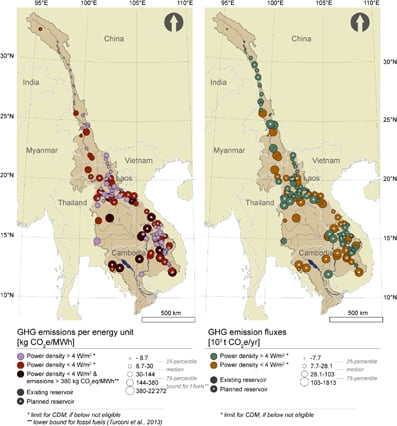
Hydropower in the Mekong river basin in Southeast Asia is not a “categorically low-emission” energy source, according to researchers who studied its long-term greenhouse-gas output.
The study – the first to assess emissions on a large scale over a lifetime of 100 years – paints a mixed picture for hydropower in the tropics. Although many of the Mekong reservoirs have emissions comparable to renewable energy sources, a large portion have considerably greater emissions, with some even matching those from fossil-fuel power plants.
The researchers believe that if low emissions are to be considered important, many factors must be taken into account and the merits of hydroelectric reservoirs must be assessed on a case-by-case basis.
“Things are rarely simple,” said Timo Räsänen of Aalto University, Finland. “[… Our] understanding should be used for developing region- and location-specific energy alternatives from a mix of energy sources that minimize the total greenhouse-gas emissions.”
The Mekong region has undergone rapid social and economic development in recent decades. Since the 1960s, to meet rising energy demands, hydroelectric reservoirs have steadily multiplied, with a sharp increase this century.
Hydropower projects are often assumed to be a low-carbon source of energy, although this is not always backed up by what little data has been collected. In 2011, for instance, the consultancy Environnement Illimité in Canada found that emissions from 18 equatorial and tropical reservoirs ranged from 2 to 4100 kg of carbon dioxide-equivalent per megawatt-hour – compared with 380 to 1300 kg from typical fossil fuel plants.
Räsänen and colleagues from Aalto University and Leiden University in the Netherlands chose the Mekong region for their analysis because of its 141 existing and planned hydropower reservoirs. Data on reservoir emissions are lacking for the Mekong region, so the team borrowed data on carbon dioxide and methane emissions from other sources, and fed them into an existing statistical model.
The researchers also incorporated basic reservoir data they collected themselves from the Mekong region, such as age, size, net primary productivity, air temperature, erosion and annual energy production. “Our study is the first to make such [a] regional analysis which also considers the change of emissions in time,” said Räsänen.
Emissions ranged from 0.2 to 1994 kg of carbon dioxide-equivalent per megawatt-hour, with a median of 26 kg, the team found. Some 80% of general hydropower reservoirs and 45% of reservoirs also used for irrigation had emissions comparable to renewable sources, while the rest had greater emissions, some beyond those of fossil-fuel power plants.
According to Räsänen, the reasons for the variability include the amount of organic matter in the reservoirs, the warmth of the reservoir (which aids decomposition), and the shape of the reservoir – with relatively large surface areas also helping decomposition. But he stresses that educated guesses can only be so accurate, and many other specific factors need to be taken into consideration.
“The existing models are relatively simple and there is room for improvement,” he said. “For example, we should develop a typology of the physical characteristics of the reservoirs, and analyse the effect of reservoir characteristics on the emissions to make better predictions.”
The team published the findings in Environmental Research Letters (ERL).



